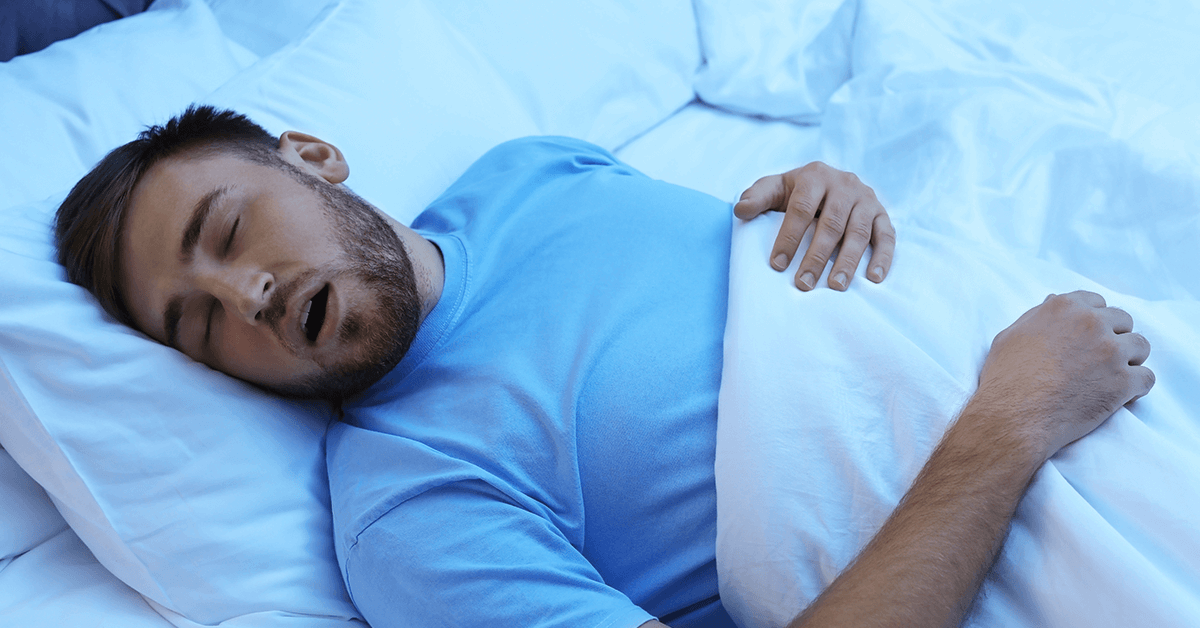
Medically reviewed by
Dacelin St Martin, MD
Triple board-certified in Sleep Medicine,
Internal Medicine, and Pediatrics.
Why Do We Snore? | Risk Factors | Snoring & OSA | Health Consequences | Sleep Divorce | Diagnosis | Treatment
Overview
Snoring is a raspy sound that originates in the upper airways of some people during sleep. It can be a source of annoyance for partners or roommates.
Almost everyone snores occasionally, but it’s more common for some: around 44 percent of males and 28 percent of females are habitual snorers, which can be defined as snoring for 3 or more nights a week.[1]
Why Do We Snore?
During sleep, the body’s muscles lose their tone and relax, including those surrounding the upper airway.
Their relaxation causes the airway to narrow, so the air passing through causes tissue in the throat to flutter and vibrate, causing the person to snore.
Risk Factors
Some people are more prone to snoring. Factors leading to an increased incidence of snoring include:
- Male gender
- Alcohol consumption before bedtime, which increases the relaxation of muscles
- Infection of the throat or sinuses, causing inflammation of tissues surrounding the airways, narrowing them
- Obesity as excess fat can cause airway obstruction
- Sedative medications can cause excessive relaxation of muscles
- Pregnancy
- Sleep deprivation
Snoring & OSA
For most people snoring occasionally usually does not carry any meaningful consequences; however, in some cases, snoring can signify a sleep-breathing disorder, like obstructive sleep apnea (OSA).
OSA is the term used to describe partial or complete blockage of the airway during sleep. It’s characterized by pauses in breathing, leading to a drop in blood oxygen saturation.
Snoring associated with OSA is usually intermixed with loud snorting or choking sounds as the person gasps for air, which can happen up to 300 times a night.
Oxygen levels drop, causing the brain to send messages to muscles, waking the person up to breathe; however, wakefulness is momentary, so these episodes are not remembered.
These sleep disruptions interfere with the sleep cycle and prevent the person from reaching REM sleep, the most restorative sleep stage.
OSA can lead to a significant decline in quality of life. Along with snoring, daytime drowsiness is another significant symptom of the disorder.
It also causes cardiovascular problems, such as high blood pressure and ischemic heart disease, making an early diagnosis imperative.
Health Consequences
Light and occasional snoring is not a significant concern. On the other hand, loud and frequent snoring (more than 3 nights a week) may indicate breathing problems during sleep.
There have been numerous studies regarding the effects of snoring on the body. Most of these studies have found links between snoring and high blood pressure, cardiovascular diseases, and stroke; however, recent research has found that OSA links snoring to these health issues. One proven health consequence of snoring (without OSA) is carotid atherosclerosis.
Studies show a link between snoring, carotid intima-media thickening, and atherosclerosis. Physiologically, atherosclerosis is characterized by a plaque buildup along the inner layers of arteries, which can lead to decreased or blocked blood flow to the brain. Over time, this places a person at a higher risk of a stroke.
A study carried out in 2008 divided 110 people into three groups based on the total time they spent every night snoring. The study found a positive dose-dependent relationship between snoring and disease manifestation, meaning the more a person snored, the higher the risk for carotid atherosclerosis.[2]
Sleep Divorce
Snoring can strain relationships and lead to a partner sleeping in a spare room or on the couch. This type of bedtime separation is called sleep divorce, which commonly occurs when a sleep-deprived spouse feels like there’s no other recourse to get a good night’s sleep.
An exhausted sleep partner may engage in sleep tactics, like having a few drinks and wearing earplugs to expedite sleep onset and drown out snoring. These types of coping mechanisms can be ineffective and be the root of long-term resentment, leading to sleep divorce. Snoring is not only a possible symptom of a health condition but can also complicate interpersonal relationships.
Diagnosis
If your partner or roommates frequently complain about your snoring loudly at night, it may be time to do something about it.
On the other hand, it may be difficult to diagnose sleep problems if you sleep alone. In this type of instance, a recording app can be used to detect snoring.
Symptoms can include waking up frequently at night choking, feeling drowsy the following day, or waking up with a headache.
Doctors can carry out a thorough checkup to determine the cause and solution for snoring.
The first step is noting a comprehensive history and taking a bed partner or roommate to your appointment will help confirm the intensity and frequency of your snoring.
Medical history, medication, smoking, alcohol use, and sleep habits are all relevant for a good diagnosis.
A physical examination usually follows with the doctor checking for inflammation, obesity, bone abnormalities, or any visible signs of concern.
Finally, based on all this information, a doctor can determine if the snoring is cause for concern.
In some cases, in-laboratory polysomnography may confirm if you suffer from OSA and need long-term therapies.
Treatment
Snoring is usually caused by a mix of many factors that ultimately lead to the narrowing of a person’s airways.
The good news is that most light snorers can resolve their snoring by making simple lifestyle changes.
In contrast, snorers who suffer from OSA need to take a therapeutic approach to manage the disorder.
Conservative Solutions:
- Obesity and significant weight gain can be substantial contributors to snoring. Losing weight and reaching a healthy BMI can help keep the airway clear and open during sleep [3]
- Avoid consuming alcohol and smoking tobacco at least four hours before sleep [4]
- Sleep on your side rather than your back[5][6]
- Try to avoid, or reduce, the use of sedative medication or antihistamines before going to bed
- Get sufficient sleep
Nasal Intervention
Decongestants
People with throat or sinus infections can benefit from using intranasal decongestants to clear up the airways before going to bed.
The relief with these aids is temporary, and decongestants are not recommended to be used for more than three days.
Nasal Surgeries
Nasal surgeries can increase the size of airways. Unfortunately, they have not been successful in relieving people from snoring and are therefore not recommended.[7]
Nasal Dilators
Nasal dilators are stiffened adhesive strips that are applied to the valves of the nose. They increase the area of the openings and decrease resistance and have been proven to reduce the intensity and frequency of snoring. This is a reasonable approach to try after trying out all the conservative methods.
Mechanical Solutions
Oral Appliance
Studies have shown that oral appliances are an effective treatment for snoring. They are mouthpieces made and fitted by dental specialists to keep the airway open while you sleep.
These mouthpieces work by adjusting the mandible’s position, retracting the tongue, and holding the soft palate in place.
Short-term side effects, such as mouth dryness, difficulty chewing, and jaw discomfort, have been reported by numerous users but are usually minor and go away with use.
CPAP
Continuous positive airway pressure or CPAP is an approach that involves wearing a mask covering your nose and mouth during sleep.
The mask is connected to a machine that delivers constant pressurized air to prevent the airways from collapsing.
CPAP is the gold standard for treating snoring and OSA.
Surgical Solutions
In contrast to nasal surgeries, palatal surgeries are effective in the short term though their long-term benefits are still being studied.[8][9]
Uvulopalatopharyngoplasty is a medical procedure in which the soft palate and tonsils are removed by traditional surgery or laser-assisted techniques.
Radiofrequency Palate Surgery is a method in which temperature-controlled radio frequencies are used to decrease the tissue volume of the palate, increasing the space for air to pass through.
Myofunctional Therapy
Upper airway exercises, or myofunctional therapy, such as orthodontics, is a fresh approach to treat snoring. There is limited data, but studies show that they can be quite helpful in improving symptoms.
An analysis of nine studies showed that three months of exercises involving the tongue and soft palate effectively decreased snoring intensity and duration in 211 participants. [10]
Conclusion
Snoring is a sound produced when air is forced through a narrowed or obstructed airway. Its effects can range from a simple annoyance to sleep deprivation.
Snoring can be managed by incorporating lifestyle changes, but medical intervention is necessary if there’s a sleep disorder diagnosis, like OSA.
References:
- Young, T., Palta, M., Dempsey, J., Skatrud, J., Weber, S., & Badr, S. (1993a). The Occurrence of Sleep-Disordered Breathing among Middle-Aged Adults. New England Journal of Medicine, 328(17), 1230–1235. https://doi.org/10.1056/nejm199304293281704
- Heavy Snoring as a Cause of Carotid Artery Atherosclerosis. (2008). Sleep. Published. https://doi.org/10.5665/sleep/31.9.1207
- Braver, H. M., Block, A. J., & Perri, M. G. (1995). Treatment for Snoring. Chest, 107(5), 1283–1288. https://doi.org/10.1378/chest.107.5.1283
- Franklin, K. A., Gíslason, T., Omenaas, E., Jõgi, R., Jensen, E. J., Lindberg, E., Gunnbjörnsdóttir, M., Nyström, L., Laerum, B. N., Björnsson, E., Torén, K., & Janson, C. (2004). The Influence of Active and Passive Smoking on Habitual Snoring. American Journal of Respiratory and Critical Care Medicine, 170(7), 799–803. https://doi.org/10.1164/rccm.200404-474oc
- Chen, W. C., Lee, L. A., Chen, N. H., Fang, T. J., Huang, C. G., Cheng, W. N., & Li, H. Y. (2015). Treatment of snoring with positional therapy in patients with positional obstructive sleep apnea syndrome. Scientific Reports, 5(1). https://doi.org/10.1038/srep18188
- Benoist, L. B. L., Beelen, A. M. E. H., Torensma, B., & de Vries, N. (2018). Subjective effects of the sleep position trainer on snoring outcomes in position-dependent non-apneic snorers. European Archives of Oto-Rhino-Laryngology, 275(8), 2169–2176. https://doi.org/10.1007/s00405-018-5036-y
- Virkkula, P., Bachour, A., Hytönen, M., Salmi, T., Malmberg, H., Hurmerinta, K., & Maasilta, P. (2006). Snoring Is Not Relieved by Nasal Surgery Despite Improvement in Nasal Resistance. Chest, 129(1), 81–87. https://doi.org/10.1378/chest.129.1.81
- Berger, G., Finkelstein, Y., Stein, G., & Ophir, D. (2001). Laser-Assisted Uvulopalatoplasty for Snoring. Archives of Otolaryngology–Head & Neck Surgery, 127(4), 412. https://doi.org/10.1001/archotol.127.4.412
- Levin, B. C., & Becker, G. D. (1994). Uvulopalatopharyngoplasty for Snoring. The Laryngoscope, 104(9), 1150-1152. https://doi.org/10.1288/00005537-199409000-00017
- Camacho, M., Guilleminault, C., Wei, J. M., Song, S. A., Noller, M. W., Reckley, L. K., Fernandez-Salvador, C., & Zaghi, S. (2017). Oropharyngeal and tongue exercises (myofunctional therapy) for snoring: a systematic review and meta-analysis. European Archives of Oto-Rhino-Laryngology, 275(4), 849–855. https://doi.org/10.1007/s00405-017-4848-5

